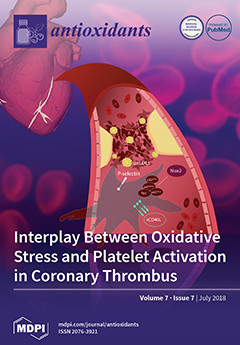The objective of this work was to determine the concentration of total phenols, total flavonoids, hydroxycinnamic acids, and proanthocyanidins present in crude extracts of
Quercus laurina,
Q. crassifolia, and
Q. scytophylla bark. They were extracted by ethanol (90%) maceration and hot
[...] Read more.
The objective of this work was to determine the concentration of total phenols, total flavonoids, hydroxycinnamic acids, and proanthocyanidins present in crude extracts of
Quercus laurina,
Q. crassifolia, and
Q. scytophylla bark. They were extracted by ethanol (90%) maceration and hot water. The antioxidant capacity was determined by the ability to capture OH•, O
2•
−, ROO•, H
2O
2, NO•, and HClO. The hot water crude extract of
Q. crassifolia was chosen to be concentrated and purified due to its higher extraction yield (20.04%), concentration of phenol compounds (747 mg gallic acid equivalent (GAE)/g, 25.4 mg quercetin equivalent (QE)/g, 235 mg ChAE/g, 25.7 mg chlorogenic acid equivalents (ChAE)/g), and antioxidant capacity (expressed as half maximal effective concentration (EC
50, µg/mL): OH• = 918, O2•
− = 80.5, ROO• = 577, H
2O
2 = 597, NO• ≥ 4000, HClO = 740). In a second stage,
Q. crassifolia extracted with hot water was treated with ethyl acetate, concentrating the phenol compounds (860 mg GAE/g, 43.6 mg QE/g, 362 ChAE/g, 9.4 cyanidin chloride equivalents (CChE)/g) and improving the scavenging capacity (OH• = 467, O2•
− = 58.1, ROO• = 716, H
2O
2 = 22.0, NO• ≥ 4000, HClO = 108).
Q. crassifolia had the highest polyphenolic concentration and the better capacity for scavenging reactive species, being a favorable candidate to be considered in the development of new products.
Full article






